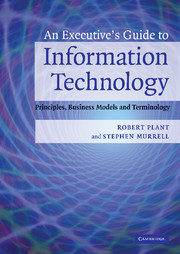Book contents
- Frontmatter
- Contents
- Introduction
- A ACM (Association for Computing Machinery) to Audio
- B Backup to Business process re-engineering
- C C, C++, C# to Cracking
- D Database to Dynamic web pages
- E e-Commerce/e-business to European Union Directive on Privacy and Electronic Commerce 2002
- F Fiber optics to Fuzzy logic
- G to H Global positioning system to Hypertext, HTML
- I ICANN (Internet Corporation for Assigned Names and Numbers) to ISP (Internet service provider)
- J to L Java to Logic programming
- M Machine learning to Multicast
- N Natural language processing (NLP) to Normalization
- O Object-oriented to Outsourcing
- P Packet switching and circuit switching to Public key-private key
- Q to R Quantum computing to RSS (Really simple syndication)
- S Sarbanes-Oxley Act of 2002 (SOX) to Structured design methodologies
- T to U T-Carrier to URL (Uniform resource locator)
- V Value added network (VAN) to Voice over IP (VoIP)
- W W3C (the World Wide Web Consortium) to WYSIWYG
- X to Z X.12 to Zip
- Index
- References
T to U - T-Carrier to URL (Uniform resource locator)
Published online by Cambridge University Press: 17 May 2010
- Frontmatter
- Contents
- Introduction
- A ACM (Association for Computing Machinery) to Audio
- B Backup to Business process re-engineering
- C C, C++, C# to Cracking
- D Database to Dynamic web pages
- E e-Commerce/e-business to European Union Directive on Privacy and Electronic Commerce 2002
- F Fiber optics to Fuzzy logic
- G to H Global positioning system to Hypertext, HTML
- I ICANN (Internet Corporation for Assigned Names and Numbers) to ISP (Internet service provider)
- J to L Java to Logic programming
- M Machine learning to Multicast
- N Natural language processing (NLP) to Normalization
- O Object-oriented to Outsourcing
- P Packet switching and circuit switching to Public key-private key
- Q to R Quantum computing to RSS (Really simple syndication)
- S Sarbanes-Oxley Act of 2002 (SOX) to Structured design methodologies
- T to U T-Carrier to URL (Uniform resource locator)
- V Value added network (VAN) to Voice over IP (VoIP)
- W W3C (the World Wide Web Consortium) to WYSIWYG
- X to Z X.12 to Zip
- Index
- References
Summary
Foundation concepts: Network, Bandwidth.
Definition: T-Carrier is the generic name for digital high-speed data-transmission lines more specifically known in the United States as T-1, T-2, etc.
Overview
The basis of the T-Carrier system is the digital Channel, designated DS0 or T-0. A single DS0 channel has a capacity or Bandwidth of 64 kbps (64 000 bits per second), which is the amount of carrying capacity that Bell Labs originally defined as necessary to carry a digitized voice signal over their network. Originally, the name T-1 was used for a digital transmission channel with a bandwidth of 1544 kbps that carried 24 separate DS0 channels together with one 8 kbps channel for system-related information. Now the technology may be slightly different, and T-1 has become a less specific name for any 1544 kbps digital carrier. Similar names (T-2, T-3, etc.) are used for higher-bandwidth carriers:
a T-1 line is equivalent to 24 channels or 1.544 Mbps,
a T-2 line is equivalent to 96 channels or 6.312 Mbps,
a T-3 line is equivalent to 672 channels or 44.74 Mbps,
a T-4 line is equivalent to 4032 channels or 274.2 Mbps, and
a T-5 line is equivalent to 5760 channels or 400.3 Mbps.
although it is not common to hear of anything other than T-1 and T-3. In Japan, exactly the same system is used, except with the letter J instead of T. Originally T-lines were made of copper wire, and the designation FT was used for fiber optics, but now the distinction is often ignored.
- Type
- Chapter
- Information
- An Executive's Guide to Information TechnologyPrinciples, Business Models, and Terminology, pp. 315 - 328Publisher: Cambridge University PressPrint publication year: 2007



